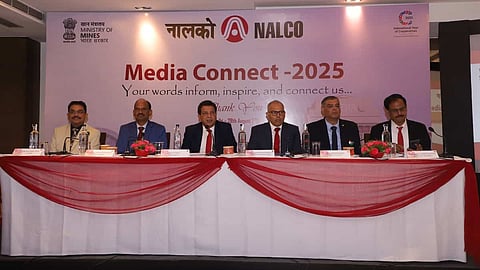
- News Updates
- PSU Watch
- Defence News
- Policy Watch
- हिन्दी न्यूज़
- Jobs Watch
- States News
- Event News

New Delhi: As Navaratna PSU National Aluminium Company (NALCO) Limited sets its eyes on attaining the Maharatna tag by 2030, it has lined up brownfield expansion projects for the next five years, starting with an alumina refinery, followed by a smelter plant and a coal-based captive power plant. Speaking to the media on Thursday, NALCO Chairman and Managing Director (CMD) Bijendra Pratap Singh said, “We are planning to become a Maharatna in the next five years. Our current turnover is around Rs 17,000 crores. Once we add the refinery, our turnover is expected to go to Rs 19-20,000 crores. And after we add the smelter and the thermal power plant, it will cross Rs 25,000 crore.”
Maharatna status requires PSUs to have an average annual turnover of over Rs 25,000 crore in the last three years, among other financial and operational benchmarks. Singh’s comments suggest NALCO is banking on these projects to push it into the next league of central public sector enterprises.
The PSU is expanding the 5th stream of its Damanjodi alumina refinery by 10 lakh tonnes per annum (TPA), which will take its total alumina production capacity to 3.1 million tonnes annually from 2.1 MT at present. “We are going to add one more refinery of 10 lakh tonnes which is going to increase our alumina production capacity to 31 lakh tonnes on a yearly basis. We will be having excess of alumina, which is what our strategy is. Let’s have excess of Alumina and then sell it to the domestic market or export market,” Singh told reporters. The refining capacity addition will cost around Rs 5,600 crore.
On global trade dynamics, he added that the impact of recent US tariffs on aluminium imports had been limited for NALCO since its exports to the country were already small. “We are now looking at the United Kingdom (UK) as a potential market for exports. And we are also focussing on increasing value-added products in our portfolio as part of our strategy to deal with the trade tariffs.” However, Singh admitted that higher alumina availability in the Indian market after the tariffs has led to price pressure domestically.
As part of its expansion strategy, NALCO is lining up Rs 30,000 crore of investment in a new 0.5 million tonne aluminium smelter and a 1,080 MW captive thermal power plant, both to be located at Angul.
Of this, Rs 18,000 crore has been earmarked for the smelter and Rs 12,000 crore for the power plant. “We are thinking of having some JV arrangement with may be Coal India, NTPC or Singareni Collieries, because with these companies, we will be assured of coal supply,” Singh said. A consultant is currently preparing a Detailed Project Report (DPR) for the plant, which is targeted for commissioning by 2030.
To reduce costs, the company has been shifting from purchased coal to production from its own coal mines. “Around 35–40 percent cost of alumina is power cost. So, we have our own coal-based power plants. Currently, we have 1,200 MW of captive power plants for meeting our power requirements. Earlier we used to take around 7.2 million tonnes of coal from Northern Coalfields Limited (a Coal India subsidiary). For the last two-three years, we have been getting coal from our own mines and hence, the cost of production has gone down by around Rs 200–300/tonne. We have currently have coal mines with capacity of 4.4 MT and we plan to acquire more mines,” Singh said.
As far as bauxite is concerned, the NALCO CMD said the company plans to start the Pottangi mines by Q4 of FY2025-26.
Singh outlined a three-phase growth strategy for the PSU to become a Maharatna by 2030. “Our short-term strategy involves focussing on maximising our capacities. All our units are running at more than 100 percent of our rated capacity. We are trying to increase production from the existing units and reduce the cost by increasing efficiencies, increasing the specific consumption and increasing the human capabilities,” said the NALCO CMD.
The company’s mid-term strategy, in the next two-three years, is going to focus more on value-added products and integrating green energy into the processes and also Industry 4.0 practices. The long-term growth strategy, on the other hand, focusses on brownfield expansions in order to augment production capacity and take the leap to becoming a Maharatna PSU, said the CMD.
NALCO’s ambitious Rs 30,000-crore plan comes at a time when global aluminium demand is being reshaped by trade tariffs, energy transition pressures and rising competition from private players such as Hindalco and Vedanta. Its strategy to focus on captive raw materials and value-added products could improve margins, but heavy reliance on coal-based power plants raises questions about long-term carbon competitiveness, especially as the global market pivots towards green aluminium.
If executed on time, the expansion will help NALCO clear the turnover hurdle for Maharatna status. However, achieving global competitiveness will require parallel investments in low-carbon energy sources and technology upgrades beyond the immediate brownfield push.
(PSU Watch– India's Business News centre that places the spotlight on PSUs, Bureaucracy, Defence and Public Policy is now on Google News. Click here to follow. Also, join PSU Watch Channel in your Telegram. You may also follow us on Twitter here and stay updated.)
